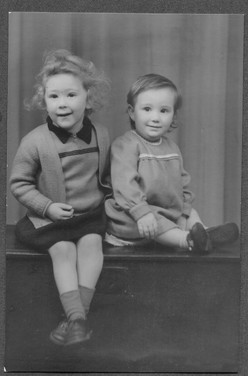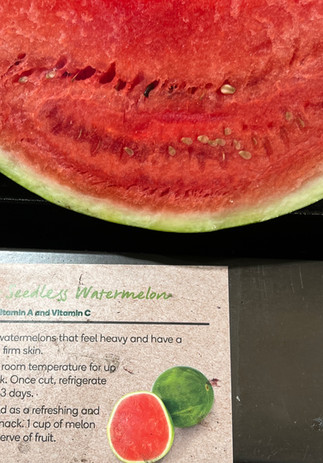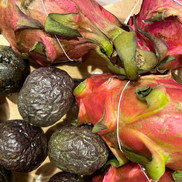So much to see, do, experience ... always
- rosemary
- Aug 23, 2022
- 7 min read
“It's never too late to have a happy childhood.” Tom Robbins

Yes it's another painting from my desk diary. It's called Marguerite-Thérèse (Margot) Berard - a rather wonderful name in itself - and it's painted by Renoir. She is the third child of his patron Paul Berard, a patron who became a good friend. At the time of the painting she was five years old and Renoir was staying with the family - for the first time - he later visited them often - at their country home near Dieppe. The story goes that he came across her, weeping on the stairs after an unhappy lesson with her German teacher and so Renoir painted her to cheer her up. From weeping on the stairs to such joy, such excitement, such anticipation of good things to come - such is childhood.
Do click on the picture to get a closer view of those eyes, that hair ...
To prove it I went back to photographs of myself at the same age - very few and far between and here are three - in the one on the left I am younger - only around three, but in the other two I would be about the same age as Margot - maybe slightly older.
Living in the moment in all three - hair all over the place, like Margot's, but happy, almost ecstatic, on the beach especially, although, of course, there would have been many, many moments of tears and tantrums, possibly just moments before or after the photographs themselves. What remains is the idea of someone who, although noticeably poor could smile. No - more than smile - could be joyful, even though sitting on a beach wrapped up in a warm coat because it was so cold. Why so joyful? Because it was something new, an experience outside of everyday life, a place far away from my home in a very ordinary London suburb. And besides I was having my photograph taken, just as Margot was being painted. Not something that happened very often back then. From these few photographs one constructs a whole personality - at least I have. I now see myself as and adventurous happy-go-lucky kind of child but was I really?
“I do not miss childhood, but I miss the way I took pleasure in small things, even as greater things crumbled. I could not control the world I was in, could not walk away from things or people or moments that hurt, but I took joy in the things that made me happy.” Neil Gaiman

Margot sitting on the stairs in tears, does not stay sad for long, because this kind and talented young man (he painted this self-portrait the year before) - who would have been in his late 30s at the time, and not fully the famous artist he would become - took pity and fixed her for all time as this most beautiful young child whose wonderful blue eyes express something, completely indescribable for me. Which meets Renoir's own criteria for a great work of art:
"Shall I tell you what I think are the two qualities of a work of art? First, it must be indescribable, and, second, it must be inimitable.” Pierre-Auguste Renoir
It was a moment in time - or as one critic describes his work: "snapshots of real life, full of sparkling color and light."
It was a painting that was unfamiliar to me and which is not featured in the few websites that focus on Renoir's work which I have visited for this post . And again I ask why? This morning I turned over the page on my desk calendar and there was this little girl - so alive - looking off camera as we say today and she was - I don't know - so real. The expression in her eyes was so hopeful, so excited. And how, on earth did Renoir capture that with a paint brush? Even a camera would struggle to express such emotion.

But then we grow up. Here I am as a teenager, looking miserable, which I now recall as being how I was at that time - mostly. But is that true? Like childhood there are very few photographs of this time. Have I based all my memories of misery on this one photograph? In this case no. It just confirmed the miserable memories that I had, for I rediscovered it quite late in my life, when my sister was having a clear out of boxes of photographs and other memorabilia.
But all was not lost and now here I am living in luxury in Australia - a sort of lesser Paradise on earth, with a mostly loving husband - well we've been together a very long time - wonderful children and grandchildren, sitting at my computer, pondering on it all. A life, like most lives, full of happy moments, sad moments, even moments of despair balanced by moments of ecstasy and hope. With still more to come.

So now here I am, an old lady in the company of my book group friends - I call this the old ladies book group - because we are, and I am one of the youngest. These ladies, now hampered by physical issues in some cases, still manage to live a life that is full, even adventurous. They travel often overseas; they read; they go to concerts and films, and all manner of other events; they socialise; their minds are incredibly alert and vibrant. Doubtless all of us have had highs and lows in our lives - indeed I know this for a fact. We have made mistakes, but that does not lessen the pleasure of small things we encounter every day.
"The advantage of growing old is that you become aware of your mistakes more quickly. ” Pierre-Auguste Renoir
Neil Gaiman said he missed that childlike pleasure in small things, and many will tell you that ageing takes that away from you. But does it? Should it? I went for a walk this morning - rain was threatened and so I thought I should take advantage of a relatively clear moment. My walks are not very varied. I have grown to be an unadventurous adult, even a cowardly one, and yet every walk is different - a mini adventure in fact. You notice different things - often small, even tiny things. Today I was looking for patterns because that's this week's photography subject, and found beauty in unexpected places: a somewhat decayed edging to the road; some kind of old marker; tree bark - a passer-by suggested it was cork; and a puddle reflecting telegraph wires.
All ordinary, small things but which gave me pleasure, not least because the wonderful photo editing technology which is on all of our digital devices allowed me to crop them a bit to make them look better. Well not all of them actually - just the first two, and then minimally, because the camera on my phone is so superb. Not like the box brownies that took the non professional shots above although the first one was taken by a professional photographer.
But has this got anything to do with food? I'm supposed to be food focussed after all. Well yes, like just about everything in life, you can apply the idea of hope and joy, and satisfaction that creativity gives to the subject of food. The sheer beauty of food before you do anything to it - potential food if you like for starters - and the tales it tells, if you care to think on it, of the millennia that have brought it in such shining perfection to your local supermarket:
Then there's the pleasure of imaging what you can do with it; the adventure of seeking something new to try; the sensual pleasure of preparing the ingredients and the anticipation of what it might all taste like. The senses come into play again as the food is cooked and finally there is the joy of giving others pleasure, not to mention yourself, as it is eaten. Unless of course it's a disaster - or even not very wonderful - as it often is, but even then, as Renoir says - we can learn from the mistakes and a final disappointing result does not take away from all of the hope and the pleasure that went into its making. So yes, food is entirely relevant. Take pleasure in the process if not the result:
"Work lovingly done is the secret of all order and all happiness." Pierre-Auguste Renoir
And besides as he also says:
"One must from time to time attempt things that are beyond one's capacity." Pierre-Auguste Renoir

Was anything beyond his capacity? Looking at his paintings, each one a masterpiece, one wonders if he ever was so dissatisfied that he threw them away. This one, another little-known portrait is a portrait of Margot's mother. Again - such an emotional portrait. She is beautiful, even if perhaps not in the generally accepted sense of the word. But such beauty in the expression on the face. And how is it that these lesser-known paintings do not receive the attention of all those more well-known ones? Somehow it makes the connection when you find them, even more personal, gives you a sense of personal discovery.
I tried to find out more about Margot in later life - not much to tell - she married her cousin and had children. When her father died the portrait was left to her and she kept it until the days of the Great Depression when it had to be sold to raise much needed funds. It was sold for a mere US$16,000 before being left to the Met in 1960. I wonder how much it would be worth now, though I'm guessing it's not going to be sold anytime soon.
But as I searched I found that a singer called Judy Small wrote a song about this painting, a print of which hangs in her home. Such was its power. Here are some of the words she wrote - rather better than my own - not quite top standard but heartfelt at least:
"I was stunned to find tears in my eyes as I stared at her face
The soul of the child shining forth in those eyes so clear
Paint on a canvas that thrilled me right down to my core
A portrait of hope for the future is Margot Berard ...
So whenever I feel that this planet is governed by fools
That the battle is lost and there's no point anymore
I remember that print sitting there in its frame on my wall
The original hangs in the Met in Manhattan first floor." Judy Small

Yes - soul - that's what it is. And hope that all will be well. And you can find it everywhere. Just look.

























Comments